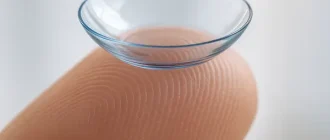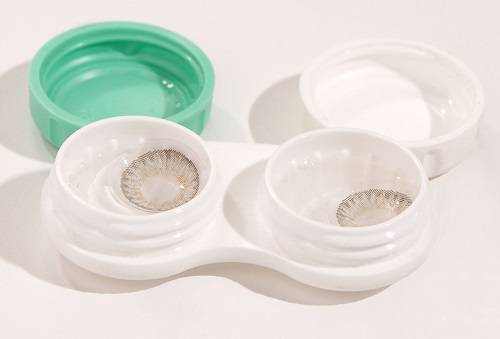The diameter of the contact lenses is a crucial consideration when choosing the best contacts. The size (diameter) of the lenses is commonly given in millimeters. A good fit is important for comfort and clear vision. When it comes to knowing contact lens diameter, keep the following things in mind:
- Contact lens diameters typically range from 13 to 14 millimeters.
- A diameter that is either too large or too tiny may cause pain and annoyance. The lenses may not remain in position or shift around excessively.
- The lens’s diameter has an impact on how it rests on your eye, so it’s crucial. Although a lens that is too small may slide about and impair vision, a lens that is too huge may pinch and be uncomfortable.
- You must see an optometrist who will measure your eyes, propose the best size, and establish your contact lens diameter.
- Specialty lenses like scleral or toric lenses often employ high-diameter lenses.
- The diameter of contact lenses varies across brands.
- Different-sized lenses should not be used since they may not fit properly and be uncomfortable.
- Your eyes may experience pain, irritability, and even injury if the contact lens diameter is off. For comfortable and secure wear, it’s crucial to acquire the appropriate fit.
- The comfort of contact lenses may be affected by choosing the right diameter. Although a lens that is properly fitted may not be noticed, one that is too large or too tiny may be uncomfortable or even painful.
While choosing contact lenses, base curve and diameter are also crucial considerations. Although the diameter impacts how the lens rests on the eye, the base curve affects how the lens fits around the cornea. For optimal comfort and clarity of vision, a lens must have the right base curve and diameter.
What is the diameter of contact lenses? Why is diameter important?
The diameter of a contact lens is measured from edge to edge. It is essential to have a good fit since it has an impact on the lens’s movement and coverage. To guarantee appropriate tear exchange, a well fitting lens should fully cover the cornea and extend an additional 1 millimeter around the whole circle of the cornea. Another factor in avoiding pain, irritability, and problems with eye health is the diameter of a contact lens. The contacts could fit too loosely or too firmly if the diameter is off. Clear eyesight and long-term comfort require properly fitted contacts.
How to Determine Your Diameter
The size and shape of your cornea must be taken into account while choosing the correct diameter for your contact lenses. The base curve and other variables, such as your eye size, may affect the contact lenses’ average diameter of 14mm. Your eye doctor will precisely measure your cornea before recommending a contact lens with the appropriate diameter. The way the contact lens rests on your eye may be impacted by even a little variation in the base curve or diameter parameters.

What does a high diameter mean?
When contact lenses have a high diameter, they are bigger than the typical 14-mm lens size. Although the average size suits the majority of individuals, those with bigger eyes may need a wider diameter for adequate corneal covering.
Big eyes “may land closer towards the 14.5mm end of the spectrum,” according to Deliver Contacts.
It’s crucial to remember that the diameter must function in conjunction with the other contact metrics, including the base curve. In order to prevent pain, irritability, or other problems with eye health, it’s essential to acquire a suitable fit.
Why Does Diameter Vary in Brands?
There is no one-size-fits-all approach to contact lenses. Because of this, while comparing several brands, you could detect a difference in diameter. To make their lenses comfortable and secure to wear, each brand employs a distinct lens design and material that calls for certain measurements.
The American Optometric Association claims that “to fit the size and shape of your cornea, manufacturers make lenses in a range of diameters. By doing this, you can be sure that your contacts will fit your eye properly and feel as natural as possible.”
For instance, Bausch + Lomb Ultra lenses have a diameter of 14mm, whereas Air Optix Aqua lenses are 14.2mm in diameter. As long as your eyes are properly fitted, this variance is typical and shouldn’t worry you.
Can you wear lenses with different diameters?
Using lenses with various diameters is not advised since it might cause pain, irritability, and even corneal abrasions. The diameter of a contact lens is significant because it affects where the lens rests on the cornea. A lens that is too large may be overly tight and irritate the eye, while one that is too small may move about excessively. If the diameter changes, optometrists may modify the base curve to preserve a good fit and stability. Before adjusting the lens diameter, it is vital to speak with an optometrist.
Eye pain and irritability may result from changing the lens’ diameter. To maintain a good fit and prevent any possible problems, it is crucial to choose the proper diameter.
What Happens If the Diameter is Wrong?
Using contact lenses with the incorrect diameter may be uncomfortable and irritating. Although a diameter that is too big might make the lens fit too firmly on the eye, one that is too tiny can easily cause the lens to detach or fall out. This may result in difficulties applying or removing the lens and excessive lens movement that compromises comfort and vision. Over time, using lenses with the incorrect diameter might create contact lens intolerance, which can compel someone to use glasses or have laser vision correction.
Contact lens users may have issues with an improper diameter. The following are some signs that the diameter is off:
- The lens easily slips out or dislodges.
- The lens is uncomfortably close to the eye.
- Trouble putting or taking out the lens.
- Excessive lens movement that impairs comfort and vision.
How does diameter affect comfort?
The comfort level of contact lenses is significantly influenced by their diameter. The improper diameter of a contact lens may irritate the eye and potentially harm it. A lens that is too big may move about and obscure vision, while a lens that is too tiny may be uncomfortable and tight.
The lens will be loose in the eye and may fall out of position if the diameter is too large. The lens will fit snugly and be uncomfortable if the diameter is too small. On the other hand, a correctly fitting lens will adequately cover the cornea and stop the dryness brought on by an exposed cornea. Moreover, there will be enough mobility to allow for tear exchange, which aids in clearing out debris and reducing pain.
Is the base curve or diameter more important for contacts?
Both the base curve and the diameter need to be taken into account when looking for the ideal fit for contact lenses. Many optometrists believe the base curve to be the more important variable, however.
The most crucial dimension for a contact lens is its base curve, since it dictates how well the lens will fit on the cornea.
Full covering of the cornea and sufficient mobility of the lens for tear exchange are guaranteed by a correct base curve. The proper base curve is crucial for good vision and long-term comfort; however, diameter is also vital.
What is the most common base curve for contacts?
Soft disposable contact lenses typically have a base curve ranging from 8.3mm to 9.0mm, with an average base curve of 8.6mm. According to studies, base curves of 8.4mm on their own achieved an excellent or better fit in around 90% of people, while base curves of 8.4mm and 8.6mm together covered 98% of people. Not all contact lens designs have the same base curves; therefore, it’s crucial to speak with an eye specialist to find the base curve that is ideal for your particular eye shape and requirements.
What happens if the base curve is too big? Or too small?
The incorrect base curvature of a contact lens might irritate your eyes and potentially injure them. The lens may not rest correctly on the cornea if the base curve is too large, which might cause it to move around or come off easily. This may lead to blurry vision and ongoing irritation. On the other side, if the base curve is too tiny, it may press too closely on the cornea, preventing it from receiving enough oxygen and perhaps causing damage. Minor signs might include pain or red, dry, or irritated eyes. It’s crucial for contact lens wearers to speak with an eye specialist to make sure their base curve and diameter are appropriate for their eyes.





